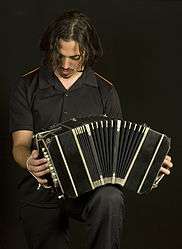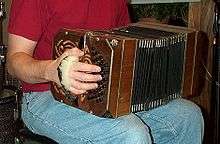Bandoneon
 | |
| Keyboard instrument | |
|---|---|
| Classification | |
| Hornbostel–Sachs classification |
412.132 (Free-reed aerophone) |
| Developed | Germany mid-1800s |
| Related instruments | |
| Chemnitzer concertina, concertina, harmonica, melodeon, reed organ, yu | |
| Musicians | |
| Aníbal Troilo | |



The bandoneon (or bandonion, Spanish: bandoneón) is a type of concertina particularly popular in Argentina, Uruguay, and Lithuania. It is an essential instrument in most tango ensembles from the traditional orquesta típica of the 1910s onwards, and in folk music ensembles of Lithuania.
History
The bandoneon, so named by the German instrument dealer, Heinrich Band (1821–1860), was originally intended as an instrument for religious and popular music of the day, in contrast to its predecessor, more folk music inclined German concertina (or Konzertina).[1]:16 Around 1870, German and Italian emigrants and sailors brought the instrument to Argentina, where it was adopted into the nascent genre of tango music, a descendant of the earlier milonga.[2]
By 1910 bandoneons were being produced expressly for the Argentine and Uruguayan markets, with 25,000 shipping to Argentina in 1930 alone. However, declining popularity and the disruption of German manufacturing in World War II led to an end of bandoneon mass-production.[1]:17
Original instruments are displayed in German museums, such as the Bandoneon Museum der Familie Preuss in Lichtenberg and the collection of the family Steinhart in Kirchzarten, Freiburg.
Bandoneons were historically produced primarily in Germany, and were never produced in Argentina itself despite their popularity. As a result, by the 2000s, vintage bandoneons had become rare and expensive (US$4,000), limiting prospective bandeonists. Accordingly, in 2014 the National University of Lanus in Buenos Aires announced their development of an affordable Argentine-made bandoneon, which they hope to market for one-third to one-half of the cost of vintage instruments.[3]
Play
As with other members of the concertina family, the bandoneon is held between both hands, with pushing and pulling motions forcing air through its bellows, which is routed through reeds by pressing its buttons. As a concertina, the bandoneon's buttons travel parallel with the bellows, versus perpendicular on an accordion.
Unlike a piano accordion, but similar to a melodeon or Anglo concertina, a given bandoneon button produces different notes on the push and the pull (bisonoric). This means that each keyboard actually has two layouts: one for opening notes, and one for closing notes. Since the right and left hand layouts are also different, a musician must learn four different keyboard layouts to play the instrument.[1]:18
These keyboard layouts are not structured to facilitate playing scale passages of single-notes, but rather to facilitate playing chords as per its original purpose of supporting singers of religious music in small churches with no organ or harmonium, or for clergy requiring a portable instrument (missionaries, traveling evangelists, army & navy chaplains, etc.)
Unisonoric
While the standard bandoneon is bisonoric (different note on push and pull), some bandoneon variants are monosonoric—aka, unisonoric—(same note on push and pull). These include the Ernst Kusserow and Charles Peguri systems, both introduced around 1925.[1]:18[4]
Players
The Argentinian bandleader, composer, arranger, and tango performer Aníbal Troilo was a leading 20th century proponent of the bandoneon. Ástor Piazzolla played and arranged in Troilo's orquesta from 1939 to 1944. Piazzolla's "Fugata" from 1969 showcases the instrument, which plays the initial fugue subject on the 1st statement, then moves on to the outright tango after the introduction. With his solos and accompaniment on the bandoneon, Piazzolla combined a musical composition much derived from classical music (which he had studied intensively in his formative years) with traditional instrumental tango, to form nuevo tango, his new interpretation of the genre.
Other prominent players
- Eduardo Arolas (1892–1924)
- Daniel Binelli
- Miguel Caló
- Tránsito Cocomarola
- Claudio Constantini
- Héctor del Curto
- Maximiliano D'Ambrosio
- Leopoldo Federico
- Richard Galliano
- Juan Pablo Jofre
- Rubén Juárez
- Per Arne Glorvigen
- Jonathan Goldman
- Koji Hirata
- Gianni Iorio
- Ryōta Komatsu
- Carel Kraayenhof
- Pedro Laurenz (1902–1972)
- Pedro Maffia (1899–1967)
- Rodolfo Mederos
- Gabriel Merlino
- Alexander Mitenev
- Gordon Mumma
- Pauline Oliveros
- Hermeto Pascoal
- Ástor Piazzolla (1921–1992)
- Mario Stefano Pietrodarchi
- Kimmo Pohjonen
- Michel Portal
- Gabriel Rivano
- Dino Saluzzi
- Richard Scofano
- Alin Stoianovici
- John Spiers
- Aníbal Troilo (1914–1975)
- Mika Väyrynen
- Heli Siekkinen (accordion and bandoneón)
Construction
A look inside a modern bandoneon:
References
- 1 2 3 4 Alejandro Marcelo Drago (2008). Instrumental Tango Idioms in the Symphonic Works and Orchestral Arrangements of Astor Piazzolla. Performance and Notational Problems: A Conductor's Perspective. ProQuest. ISBN 978-0-549-78323-7.
- ↑ Carlos G. Groppa (30 December 2003). The Tango in the United States: A History. McFarland. pp. 69–. ISBN 978-0-7864-2686-7.
- ↑ Jemio, Diego (6 November 2014). "The musical key to keeping Argentina dancing the tango". BBC News. Retrieved 13 November 2014.
- ↑ Rubén Pérez Bugallo (1 January 1993). Catálogo ilustrado de instrumentos musicales argentinos. Ediciones Del Sol. pp. 77–. ISBN 978-950-9413-49-8.
External links
| Wikimedia Commons has media related to Bandoneón. |
- Proyecto Bandomecum Bandoneon's Portal Page
- Christian's Bandoneon Page




